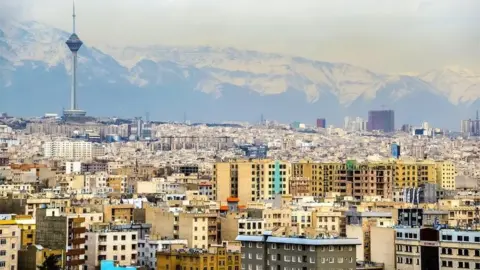How sanctions have hit ordinary Iranians
 EPA
EPAThe protests which have swept Iran in the past week reflect, in part, the impact on ordinary people of years of international sanctions.
The sanctions, lifted in 2016 as part of a deal with world powers that limits Iran's nuclear activities, resulted in a sharp decrease in spending power and forced people to cut back on buying even essential foodstuffs.
Analysis by BBC Persian of figures from the Central Bank of Iran shows that household budgets (the value of all the goods and services used by a household) have fallen in real terms from $14,800 in 2007-08 to $12,515 in 2016-17.
The analysis also shows Iran's middle class has been hit the hardest. While the average household budget has fallen 15%, the figure is 20% for middle-class families.
Economists say the situation has been exacerbated by domestic factors such as high unemployment and high inflation, which have added to the strain on Iranian families' finances.
Sanctions and inflation
The Iranian economy has been struggling with eye-watering levels of inflation over the past three decades.
In 2016-17, prices were on average 22 times what they were 20 years earlier.

While wages kept up with inflation in the 1990s and early 2000s, over the past 10 years they have lagged far behind.
On top of this, since 2009 the Iranian economy has suffered sluggish, or even negative, growth, leading to stagnating wages and soaring unemployment.
This coincided with the withdrawal of government subsidies on food and energy, and their replacement with monthly cash handouts.
The economic downturn since 2009 was partly due to sanctions targeting Iran's crude oil exports, which had a critical impact on government revenues and the wider economy.
Although the sanctions have now been lifted, their impact is still being felt - as evidenced by the widespread street protests that started a week ago.
Shrinking food baskets
The most obvious impact of the sanctions was on the dining tables of ordinary people.
The average consumption of many food staples such as bread, milk and red meat has decreased between 30% and 50% over the past 10 years.

Back in 2006, Iranian households consumed an average 1.2kg (2.6lbs) of red meat, over 4 litres (7 pints) of milk and 9kg of bread every week. By last year that had dropped to 800g - just over 2 litres and 6kg respectively.
The most obvious cause of this is inflation. While incomes rose by 370% over the past decade, the cost of red meat went up 590%, milk by 650% and bread by 1380%.
In real terms, it is now three times more expensive to buy a loaf of bread.
Housing crisis
On top of this, housing costs have soared over the past two decades.
While 20 years ago Iranian households would spend a third of their budget on food, and just a quarter of it on housing, last year those proportions were essentially reversed.
Housing now takes up more than a third of a family's budget, and less than a quarter is spent on the dining table.
 Getty Images
Getty ImagesThis has happened because Iran is suffering a serious housing affordability crisis. Over the past two decades, the average price of a home has risen at more than double the general rate of inflation.
This has led to falling rates of home ownership.
Over the past 20 years the number of families living in rented accommodation went from one-in-five to one-in-three.
As with so many countries, the situation is worst in the capital.
Fewer than half of families in Tehran now own their home. On top of that, housing in the city now takes up an average of half the household budget.
